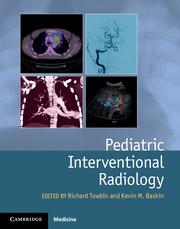3 - Thoracic interventions
Published online by Cambridge University Press: 05 June 2015
Summary
History
In the past, relatively few thoracic interventional procedures were performed in the pediatric population. The majority of thoracic procedures have been performed by physicians and surgeons in their offices, on the wards, in emergency rooms, and in the clinics. This appears to be changing. Interventionalists, using image guidance, are now performing an increasing number of diagnostic and therapeutic procedures. Traditionally, most thoracic procedures involved diagnostic aspiration (thoracentesis), drainage of pleural fluid, or biopsy of pulmonary lesions. Recently, more complex interventions involving the tracheobronchial tree have become possible. The availability of high-quality ultrasound (US), computed tomography (CT), and to a lesser extent magnetic resonance imaging (MRI), has led to a wider range and larger number of procedures being performed each year.
Interventional radiology and thoracic interventions
To achieve maximal involvement, the interventionalist needs to play an active role in the patient care team. It is important to work closely with pediatricians, oncologists, cardiologists, pulmonologists, general and cardiovascular surgeons, and others, to clearly define the goals of each procedure and develop a treatment plan. As the treatment plan is tailored to each child's needs, attention to detail is critical for a successful outcome.
Three important features of the thoracic region bear directly on management decisions for image-guided therapy. First, the bony thorax may limit the use of US. Therefore transducer selection is important. Whenever possible, use of a higher frequency transducer with a small footprint is recommended. Second, air-filled lung also limits sonographic visualization. Thus the risks associated with transgression of pleura and lung parenchyma may not be predicted with US guidance. However, there are situations where US can be useful, such as for visualization of pleural and subpleural lesions and mediastinal pathology, and for evaluation of pulmonary masses or other pathology when non-aerated lung is interposed between the target and the pleura.
- Type
- Chapter
- Information
- Pediatric Interventional Radiology , pp. 97 - 150Publisher: Cambridge University PressPrint publication year: 2015



